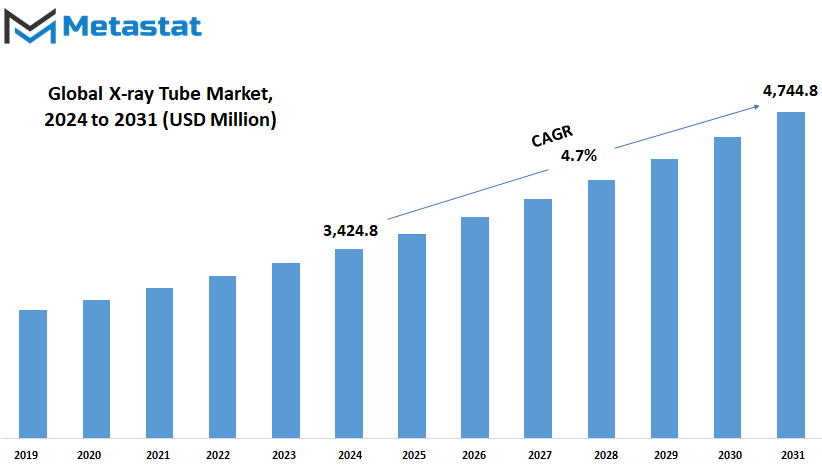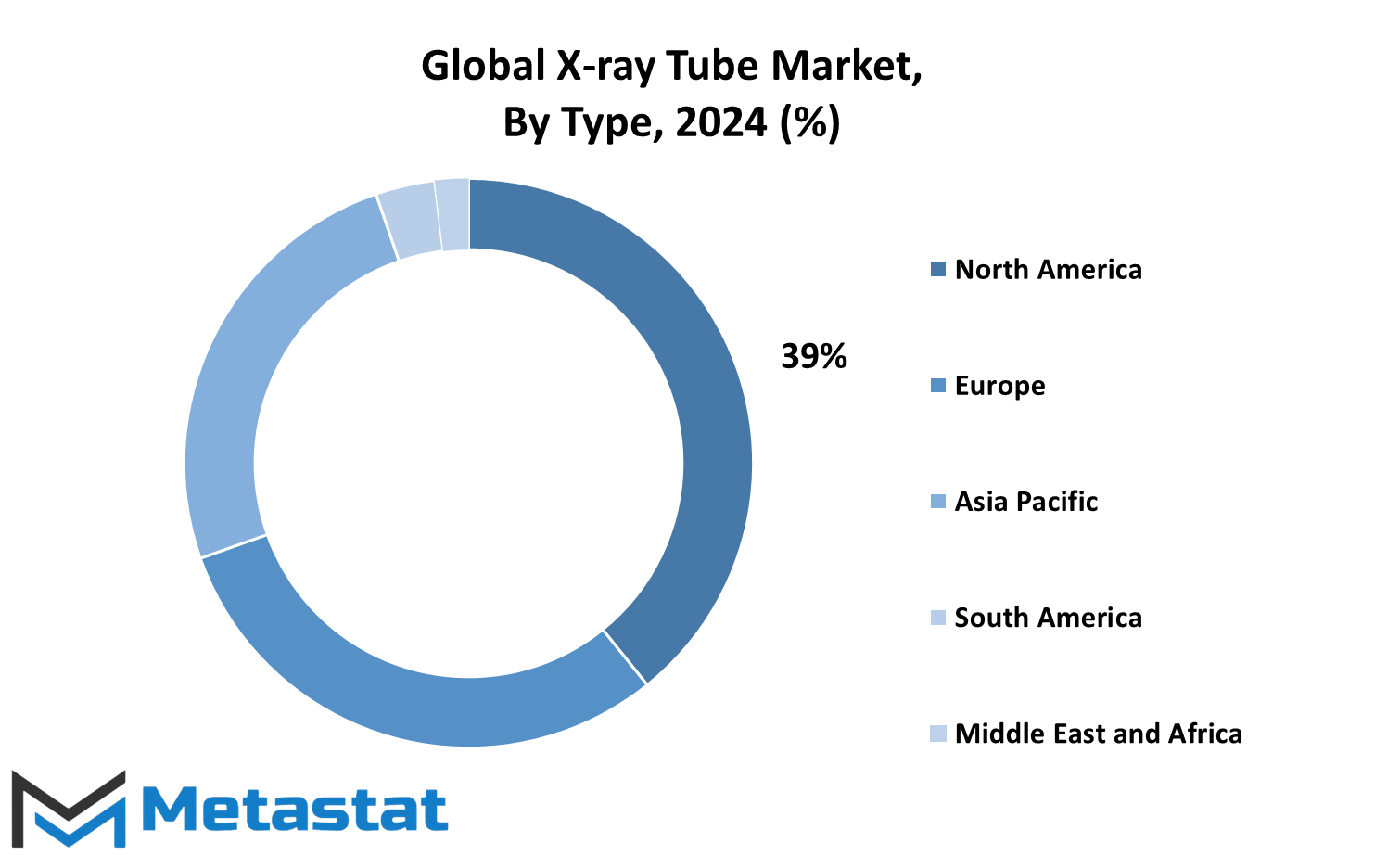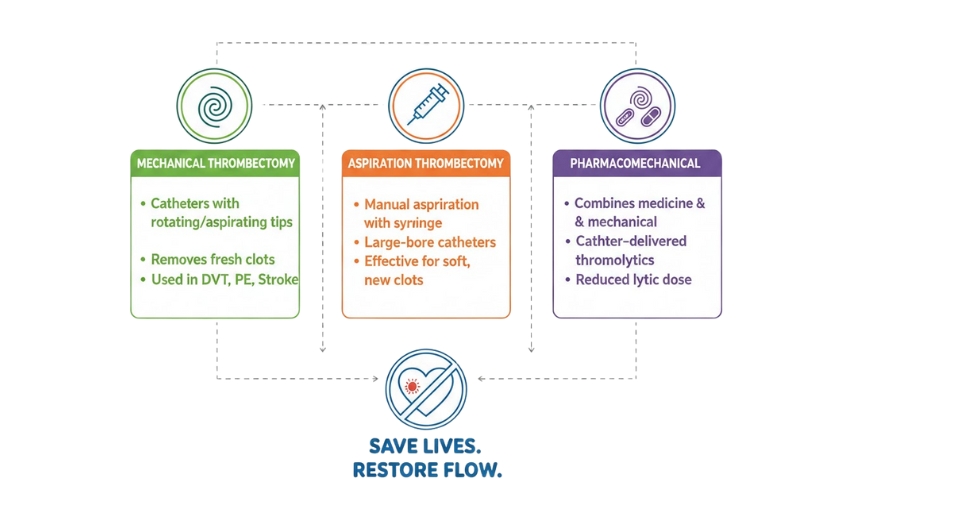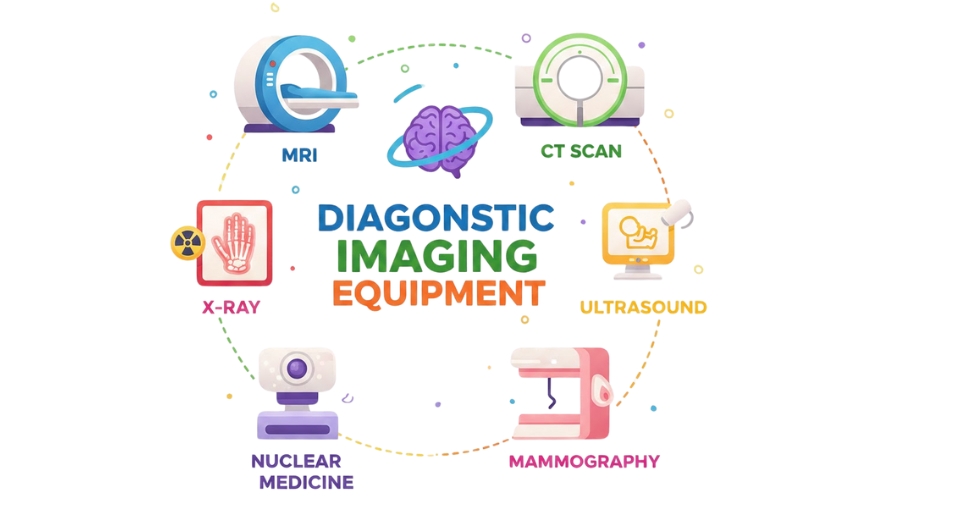MARKET OVERVIEW
The Global X-ray Tube Market represents a key segment within the overall medical imaging and industrial contexts, including the manufacturing, innovation, and application of X-ray tubes. The market serves as a key gateway in the provision of advanced diagnostic capabilities as well as non-destructive testing in an array of industries. X-ray tubes, by virtue of being integral to X-ray imaging systems, produce X-rays via high-energy electron beams striking a target material with subsequent emission of radiation, used in medical diagnostics, security screenings, and industrial inspections. The vast scale of the industry indicates its great relevance in both the health and non-health sectors.
The Global X-ray Tube Market defines its scope in the health sector through the areas of diagnostic radiography, computed tomography, and fluoroscopy, among others. Medical diagnostics and therapy now rely significantly on x ray technology for fracture diagnosis, tracking of diseases, and supervision of interventions. Improved solutions for imaging will continue demanding this, as healthcare continues to advance. The same is the case with X-ray tubes that are not medical: they are used in terms of industrial inspection and security scanning. In these applications, the use of x-ray tubes is for inspecting manufacturing flaws, for ascertaining structural integrity, and to support improvement in public safety measures.
With the introduction of new technologies, market dynamics will shift toward efficiency, durability, and precision. Manufacturers within the Global X-ray Tube Market are most likely to spend heavily on research and development of tubes that provide sharper images and lower radiation levels. Innovations such as these will run in conjunction with increased regulatory pressure and the demand for sustainability and will make companies adapt to greener production methods and materials.
Region-wise, the Global X-ray Tube Market divides into North America, Europe, Asia-Pacific, Latin America, and the Middle East. Each region would have different trends depending on the level of industrialization, health infrastructure, and technological adaptation. Developed economies with advanced health systems could invest in new and state-of-the-art X-ray technology. Emerging economies could focus on relatively affordable solutions to bridge the gap of unavailability of medical imaging facilities. Regional market dynamics will further diversify with the applications of X-ray technology in industries such as aerospace, automobile, and electronics, apart from precision quality control.
Established manufacturers as well as new start-ups would showcase the competition of the Global X-ray Tube Market. In this competitive scenario, companies will try to create distinction through new technologies, strategic relations, and network customer care services. Customized solutions and responsiveness to the end-user needs will be essential while the market continues to resolve issues that relate to cost efficiency, maintenance requirements, and performance.
Looking forward, the Global X-ray Tube Market would continue a steady growth curve because it is in sync with emergent needs of evolving technology and societal demands. The integration of artificial intelligence, high-quality imaging software, and algorithms of machine learning will revolutionize how X-ray systems function. It would enhance workflow efficiency and ensure better diagnostics; so, it is expected to face great developments in the healthcare and industrial sectors.
In a nutshell, Global X-ray Tube Market encapsulates high technology and application and promises to change the game across a wide variety of industries. The future is poised with innovating opportunities and breakthroughs that will make the role of X-ray technology forever relevant in the rapidly changing world.
Global X-ray Tube Market is estimated to reach $4,744.8 Million by 2031; growing at a CAGR of 4.7% from 2024 to 2031.

GROWTH FACTORS
The Global X-ray Tube Market is going to bear a revolutionary growth scenario in the coming years, based on several factors shaping this trajectory. Among these factors are the reasons of demand for diagnostic imaging services and a co-related increase in prevalence of chronic diseases across the globe. With time, the populations are aging, and the cases of non-communicable diseases, cancer, and cardiovascular conditions are on an upsurge. Advanced imaging solutions will be required by patients. This has increased dependence on X-ray technologies as a fundamental instrument for use in the early diagnosis and treatment planning, thereby widening the scope of the market.
Technology advancements have greatly played an instrumental role in transforming the capabilities and efficiencies of an X-ray tube. Examples include the use of digital X-ray systems with high image resolution, as well as fast processing times, which are more and more in use. These advances not only enhance the accuracy of diagnosis but also help in making the workflow processes smoother in healthcare facilities, thus benefitting the patients as well as the service provider. Such advancements obviously mark a significant milestone, where further research and development are making the systems do so much more than was originally envisioned.
Some challenges may arise as these markets grow. The most significant stumbling block for advanced X-ray tube technologies is high cost, especially in developing regions where healthcare budgets are limited. For many facilities in such regions, the investment required to upgrade to state-of-the-art equipment might be unbearable. Furthermore, regulatory hurdles and toughened safety regulations pose challenges to bringing new X-ray tube products to the market. That entails a delicate balance between innovation and access for broad adoption.
On the positive side, the growth in telemedicine and remote diagnostics does offer scope for the Global X-ray Tube Market. Essentially, as care delivery shifts towards more home-based and portable solutions, the demand will increase for compact and versatile X-ray systems. These develop technologies cater to the demands of remote communities and patients who seek easy diagnostic solutions, thereby unlocking new markets for growth. Manufacturers can harness opportunities to design pioneering products that match the changing healthcare system's requirements by focusing on these emerging trends.
In looking to the future, the Global X-ray Tube Market holds immense promise, driven by a combination of technological progress and the shifting dynamics of healthcare delivery. While challenges persist, the focus on innovation and adaptability positions the market for steady advancement in the years ahead.
MARKET SEGMENTATION
By Type
This is because the Global X-ray Tube Market is expected to find stronger growth in the future due to advancements in medical imaging technologies and an ever-growing demand for diagnostic precision. The growing need for healthcare services and technological progress in radiography mean that X-ray tubes are critical components in a variety of applications, including medical diagnostics, industrial testing, and security inspection systems. The continuous improvements in X-ray technology bring it to the forefront as one of the best areas for investment and development.
These markets are sub-classified based on type into two broad categories: rotating anode tubes and stationary X-ray tubes. Rotating anode tubes are mainly used in the medical imaging sector, through which they produce higher power outputs, which make them perfect for sophisticated techniques like computed tomography scans. With the gradual implementation of more complex imaging solutions in healthcare facilities all over the world, the need for rotating anode tubes is expected to increase. Simultaneously, stationary X-ray tubes that are relatively widely used in dental and some industrial applications offer simplicity and economy and will remain essential components.
The Global X-ray Tube Market is expected to innovate much more in the future and is driven by new emerging technologies such as artificial intelligence and machine learning. There will be increased accuracy in these diagnostic processes, making it more reliant on high-quality X-ray equipment. With increased personalization in the treatment of patients, it is obvious that the healthcare industry will also emphasize imaging technologies that give thorough and specific information on conditions of an individual patient.
The industrial usage of X-ray tubes for NDT and quality control will grow. This is due to the increased complexity of manufacturing processes in the aerospace, automobile, and electronics sectors. X-ray tubes will continue to play a prominent role in these areas in product integrity and safety measurement.
Global health issues and growing access to healthcare in developing regions will also affect the market positively. The upsurge of demand for diagnostic services in these areas would prompt more investment by governments and private entities in modern imaging infrastructure.
Combining rapid technical progress, increasing applications, and even growing interest in precise medicine, the Global X-ray Tube Market is indeed a very dynamic and rapidly advancing sector, which is about to answer developing requests from both the medical and industrial branches.
By Application
Global X-ray Tube Market is expected to grow in the coming years with several developments. The applications range widely, and now with more innovation in technology, the X-ray tubes serve a significant role in producing high imaging quality across different sectors. The adoption of the market was increased globally, and the applications included medical and dental imaging and industrial uses. Each presents an opportunity for growth as technology progresses and industries demand better solutions.
X-ray tubes have revolutionized diagnostics in the medical field, offering accurate images for healthcare professionals. These devices are indispensable in identifying fractures and monitoring conditions, as well as in advanced procedures, such as interventional radiology. Thus, manufacturers focus on providing a more efficient yet safer technology for X-ray tube applications. As the healthcare infrastructure expands further throughout the world and availability of advanced diagnostic equipment becomes more prevalent, there will be a tremendous increase in demand for innovative X-ray tubes.
Even in dental imaging, the application of X-ray tube technology has gained rapidly. From simple routine dental checkups to intricate surgical planning, X-rays have emerged as the backbone of modern dentistry. Compact and portable designs are increasingly finding their place in the market, which in turn is improving access to smaller clinics and practices. This growth is fueled by a higher awareness of oral health and the increasing prevalence of dental issues. The integration of digital imaging systems with X-ray tubes is also making procedures more precise and convenient, further driving the market.
Beyond healthcare, industrial applications of X-ray tubes represent another significant area of development. Industries rely on this technology for tasks like quality control, detecting structural flaws, and ensuring product safety. As industries increasingly use more automated and precise inspection techniques, the demand for high-end X-ray imaging solutions continues to grow. Non-destructive testing is particularly helpful in the aerospace and automotive manufacturing sectors, which depend on X-ray technology. Future innovations could include even more powerful uses of AI and machine learning in applications such as these, further increasing efficiency while decreasing errors.
The Global X-ray Tube Market has a considerable future. Continuous upgrades in materials and technologies, along with an increase in research and development investments, will eventually shape its direction. Whether it is in healthcare, dentistry, or industry, these improvements promise to make imaging solutions more effective, reliable, and accessible, in keeping with the crucial role of X-ray tubes in improving outcomes across various domains.
By End-user
Advances in technology, along with an increased need for precision in multiple industries, are expected to spur the growth of the Global X-ray Tube Market in the near future. Representing the most fundamental component of an X-ray system, x-ray tubes are being heavily used across various domains. Technological improvements in imaging and the emphasis on safety and efficiency have helped popularize X-ray technology further. This trend is fueled by its ability to offer fine details, which different sectors such as healthcare, aerospace, and manufacturing especially need.
The healthcare segment is among the largest contributors to the market. The increasing incidence of chronic diseases and an ageing population will contribute to the increase in need for advanced diagnostic technologies. Xray imaging is highly vital in diagnosis of, for instance, fractures, infections, and tumors. Innovations in portable and digital X-ray systems bring more accessible technologies that are even manifested in remote areas. Increased dependence on radiography, again underscores the importance of its role in enhancing the health outcomes of many across the world.
Similarly, the manufacturing sector places increasing reliance on X-ray inspection systems due to high-quality product production. It is possible to identify defects or inconsistencies in a product without causing damage thanks to non-destructive testing methods using the technology of X-ray. This is useful especially in very sensitive sectors like the electronics and automotive industry. In the food sector, X-ray systems are utilized for safety enhancement purposes by identifying foreign bodies in packaged products, helping meet the increased demand for quality control in food productions.
The aerospace and defense industry also would depend on X-ray systems in ensuring that their safety measures are up to par. With the accurate imaging of critical components, X-ray technology can easily pinpoint possible structural weaknesses that may become risky elements. Expect them to continuously invest in advanced X-ray systems because these industries consider reliability and safety as top priorities in managing operations.
The global X-ray tube market is expected to grow further with the development of technology. For example, the integration of artificial intelligence into X-ray systems will enable faster and more accurate imaging analysis. These new developments will, in turn, enhance the efficiency of applications in all industries, thus sustaining demand for these advanced X-ray tubes. As such, the market will continue to grow based on the varied applications and the constant drive towards improving technology related to images.
|
Report Coverage |
Details |
|
Forecast Period |
2024-2031 |
|
Market Size in 2024 |
$3,424.8 million |
|
Market Size by 2031 |
$4,744.8 Million |
|
Growth Rate from 2024 to 2031 |
4.7% |
|
Base Year |
2022 |
|
Regions Covered |
North America, Europe, Asia-Pacific Green, South America, Middle East & Africa |
REGIONAL ANALYSIS
The global x-ray tube market can be analyzed with a regional outlook to determine trends, emerging opportunities, and challenges in each region. The market is segmented into North America, Europe, Asia-Pacific, South America, and the Middle East & Africa, where distinct factors make every region unique, influencing demand and technological developments within the X-ray tubes.
Robust growth in the market was observed in North America due to the healthy presence of well-established healthcare facilities and aggressive research being conducted in medical imaging technologies. The United States dominates innovations, facilitated by high healthcare spendings, as well as a rising prevalence of chronic diseases. Canada and Mexico make their presence felt in the market with increasing investments in modern medical infrastructure and improved diagnostic services. These factors underpin the region's dominance in the market and their demand for innovation in constantly meeting the challenges posed by the need for acuter diagnostic tools.
Europe presents a dynamic landscape for the Global X-ray Tube Market, driven by countries like the UK, Germany, France, and Italy. The demand for advanced imaging technologies is supported by an aging population and the increasing incidence of diseases requiring early and accurate diagnosis. Government initiatives and funding for healthcare improvements also play a vital role. Furthermore, collaborations between leading manufacturers and research institutions foster technological progress, ensuring the region remains competitive in this field.
The X-ray tube market now sees a significant impact from the Asia-Pacific region, with growth occurring there under the involvement of countries such as China, India, Japan, and South Korea. Rapid urbanization, increasing healthcare awareness, and the growing middle class with improved medical care is the primary reason for the uptake of high-end diagnostic facilities. Added to this is local manufacturing and technological upgrades promoted by the government. As these nations keep investing in health care infrastructure, the region will witness phenomenal changes and significantly add to the global market.
South America, a regional market for Brazil and Argentina, moves steadily forward in adopting X-ray tube technologies. Healthcare accessibility improvements and growing awareness of the necessity of diagnostic imaging contribute to this growth. In like manner, the Middle East & Africa region, comprising GCC countries, Egypt, and South Africa, experiences investment in modern medical facilities. Upgrades and upgrades in health care systems from these regions hold inordinate promise for market expansion.
The global market continues to evolve as regions take tailored approaches to meet specific demands, paving the path for further advancements and widespread use of X-ray technologies.

COMPETITIVE PLAYERS
The global x-ray tube market can be analyzed with a regional outlook to determine trends, emerging opportunities, and challenges in each region. The market is segmented into North America, Europe, Asia-Pacific, South America, and the Middle East & Africa, where distinct factors make every region unique, influencing demand and technological developments within the X-ray tubes.
Robust growth in the market was observed in North America due to the healthy presence of well-established healthcare facilities and aggressive research being conducted in medical imaging technologies. The United States dominates innovations, facilitated by high healthcare spendings, as well as a rising prevalence of chronic diseases. Canada and Mexico make their presence felt in the market with increasing investments in modern medical infrastructure and improved diagnostic services. These factors underpin the region's dominance in the market and their demand for innovation in constantly meeting the challenges posed by the need for acuter diagnostic tools.
Europe presents a dynamic landscape for the Global X-ray Tube Market, driven by countries like the UK, Germany, France, and Italy. The demand for advanced imaging technologies is supported by an aging population and the increasing incidence of diseases requiring early and accurate diagnosis. Government initiatives and funding for healthcare improvements also play a vital role. Furthermore, collaborations between leading manufacturers and research institutions foster technological progress, ensuring the region remains competitive in this field.
The X-ray tube market now sees a significant impact from the Asia-Pacific region, with growth occurring there under the involvement of countries such as China, India, Japan, and South Korea. Rapid urbanization, increasing healthcare awareness, and the growing middle class with improved medical care is the primary reason for the uptake of high-end diagnostic facilities. Added to this is local manufacturing and technological upgrades promoted by the government. As these nations keep investing in health care infrastructure, the region will witness phenomenal changes and significantly add to the global market.
South America, a regional market for Brazil and Argentina, moves steadily forward in adopting X-ray tube technologies. Healthcare accessibility improvements and growing awareness of the necessity of diagnostic imaging contribute to this growth. In like manner, the Middle East & Africa region, comprising GCC countries, Egypt, and South Africa, experiences investment in modern medical facilities. Upgrades and upgrades in health care systems from these regions hold inordinate promise for market expansion.
The global market continues to evolve as regions take tailored approaches to meet specific demands, paving the path for further advancements and widespread use of X-ray technologies.
X-ray Tube Market Key Segments:
By Type
- Rotating Anode Tube
- Stationary X-Ray Tube
By Application
- Medical Imaging
- Dental Imaging
- Industrial Applications
By End-user Industry
- Manufacturing
- Healthcare
- Food
- Aerospace and Defense
- Other End-user Industries
Key Global X-ray Tube Market Industry Players
- Canon Electron Tubes & Devices Co Ltd (CANON Inc)
- COMET industrial X-ray
- Dunlee
- General Electric Company
- Gulmay
- Hangzhou Wandong
- IAE
- Kailong Medical
- Keyway Electron
- Malvern Panalytical Ltd
- Oxford Instruments PLC
- Sandt
- Siemens AG
- Varex Imaging (Varian)
- YXLON International
WHAT REPORT PROVIDES
- Full in-depth analysis of the parent Industry
- Important changes in market and its dynamics
- Segmentation details of the market
- Former, on-going, and projected market analysis in terms of volume and value
- Assessment of niche industry developments
- Market share analysis
- Key strategies of major players
- Emerging segments and regional growth potential








 US: +1 3023308252
US: +1 3023308252






